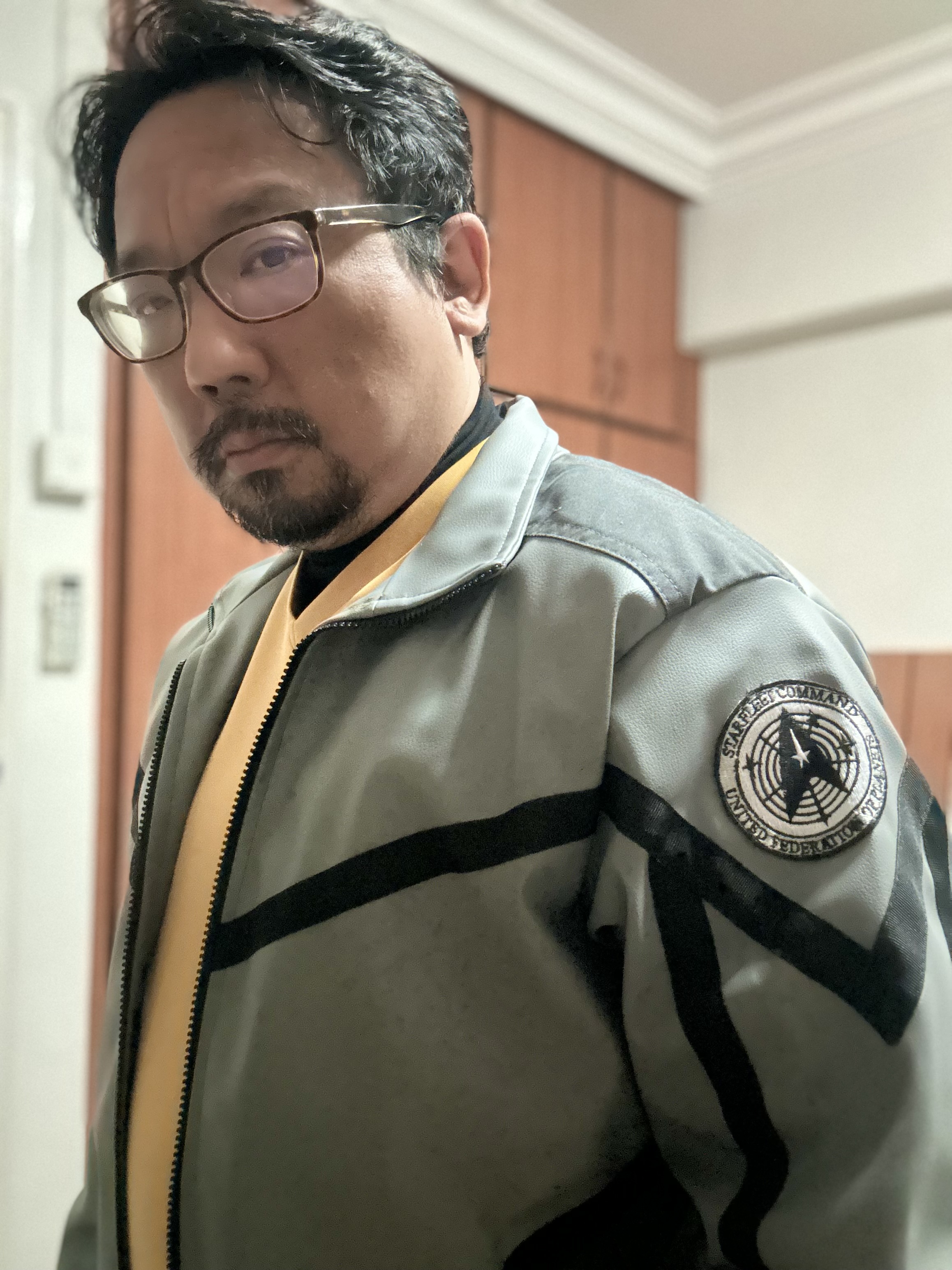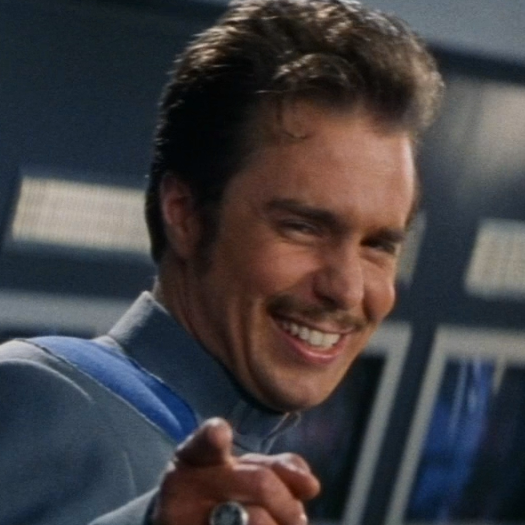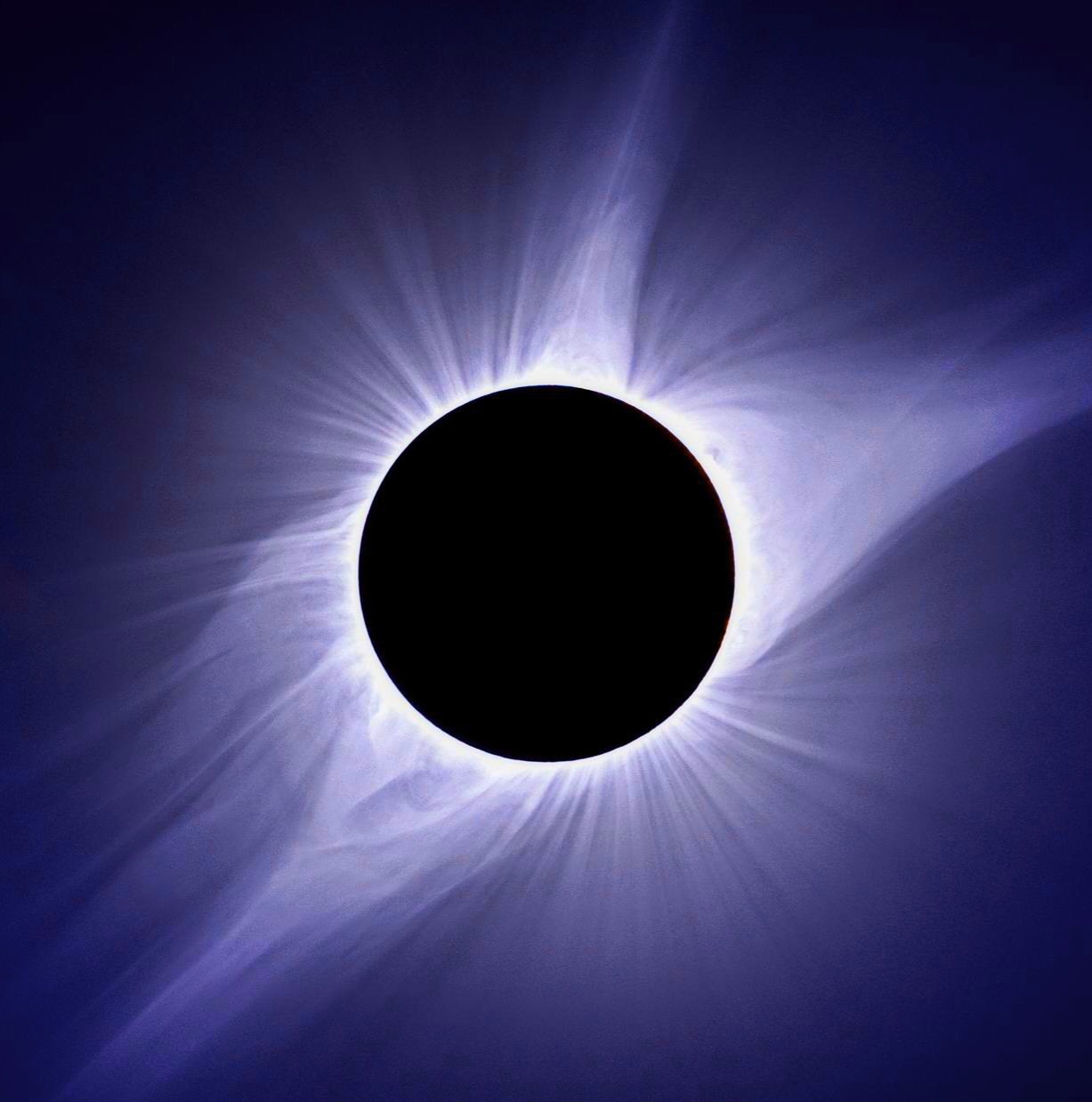In musical terms, a rhapsody is a single movement musical piece, characterized by a free-flowing structure where moods and tones can vary considerably, flowing in and out of each one. It is derived from the Greek rhapsōidia, in turn derived from rhaptein (to stitch) and ōidē (song/ode): literally, a stitched together song - with ode also meaning a poem/song of praise. A rhapsody can also mean an ecstatic, enthusiastic expression of emotion. The songs in this episode were written by Kay Hanley and Tom Polce of Letters to Cleo.
The Stardate is 2398.3. This is the first time a “subspace fold” has been mentioned on screen, but it is a ship’s ability in Star Trek Online which allows a starship to be propelled 6.66 ly forward. In essence, rather like a geodesic fold (VOY: “Inside Man”), it’s a shortcut through space - or in this case, subspace.
Usually routine ship’s comms are handled by the computer, so as all resources are being devoted to Spock’s theory, Uhura has to route them manually like an old-timey phone operator.
As previously established, Jim Kirk is serving on the USS Farragut (TOS: “Obsession”), where he has just become XO. Chapel’s message is from her future fiancé Dr. Roger Korby (TOS: “What Are Little Girls Made Of?”), regarding her fellowship in archeological medicine at the Vulcan Science Academy.
Crivo is a Portuguese word meaning “sieve”, for what it’s worth. Batel mentions the Crivian Planetary Museum, Glass Islands and Smoke Lakes.
Una notices La’An’s anxiousness at Jim’s arrival. La’An had a brief encounter with the Kirk of an alternate timeline in SNW: “Tomorrow and Tomorrow and Tomorrow”, something which the Prime Kirk is unaware of.
M’Benga calls Korby the Louis Pasteur of Archeological Medicine, a term Spock repeats in “What Are Little Girls Made Of?”.
It was noted in SNW: “Lift Us Where Suffering Cannot Reach” that the speed of subspace radio is 52,000c, and requires relays as subspace radio signals degrade over distance. According to the TNG Tech Manual, in the 24th Century subspace radio has a speed of Warp 9.9997, or approximately 79,000c, but still has an upper range of 22.65 ly, necessitating relays at 20 ly intervals (or a sector’s length, given the size expressed in Geoffery Mandel’s Star Charts).
Uhura first selects Cole Porter’s 1934 song “Anything Goes”, which geeks will probably best know as the opening number to Indiana Jones and the Temple of Doom (albeit in very badly pronounced Mandarin). The version she plays sounds to me like Eileen Rogers’ from the 1962 Anything Goes cast album.
LT Jenna Mitchell is at the Ops/Navigation position on the bridge. The bosun’s whistle signals Pike’s arrival on the bridge. Mitchell reports no other ships in the sector despite a ship apparently having just dropped off Jim.
The effect is not just limited to singing, but is making the crew do choreography as well. Having an outside force forcing characters to perform musical theatre is of course best known from Buffy the Vampire Slayer: “Once More With Feeling”, but that was from a supernatural cause.
The theme song from the titles is rearranged as a choral piece, like the title sequence was animated for the LD crossover, “Those Old Scientists”.
The bunny conversation is too specific not to be a reference to the song “I’ve Got a Theory” from “Once More With Feeling” , where a whole verse is devoted to how the explanation for the phenomenon could be bunnies. Or maybe midgets. Uhura even says later, “I have a theory.”
The idea that a subspace fissure can lead to different quantum realities was first presented in TNG: “Parallels”, where Worf passed through one that kept shifting him into different parallels. None of them were musical, sadly.
The Heisenberg compensator is a technobabble component invented for TNG by Michael Okuda and Rick Sternbach, in order to explain how the transporter would work with Heisenberg’s Uncertainty Principle, since that states that it is impossible know the momentum and position of a given particle simultaneously, which would severely hamper the transporter’s functions. How the compensator works is purposely left vague, and the usual jokey answer is, “[It works] very well, thank you.”
Una says she’s aware of her reputation, but trying a new approach. In SNW: “Spock Amok” she learned that she and La’An were known as “Where Fun Goes to Die”, but in that episode both learned to cut loose a bit by playing “Enterprise Bingo”. We found out in ST: “Q & A” that Una had a secret passion for the works of Gilbert and Sullivan. This became a matter of public record when Spock revealed it to the Court in SNW: “Ad Astra Per Aspera”.
Christina Chong has just released her first EP, “Twin Flames”. While we’re at it, Celia Rose Gooding became famous making her Broadway debut in Jagged Little Pill, Rebecca Romijn has covered “Darling Nikki” for a Prince tribute album and Carole Kane has played Madame Morrible in Wicked.
La’An’s fear of losing control is tied to her fear about her Augmented heritage and that she could be a potential Khan. The watch she holds is from the past, which she and alt-Kirk used to track down a cold fusion reactor in 21st Century Toronto. She flashes back to the night she and alt-Kirk spent in a hotel, imagining if it turned out differently (“Tomorrow and Tomorrow and Tomorrow”).
I think this is the first time that we’ve heard Batel’s first name, which is Marie. The map showing the subspace network shows the fissure in proximity to Cajitar (SNW: “The Broken Circle”) which is appropriately marked with both Federation and Klingon colors. We also see listed the USS Lexington (NCC-1709), Kongo (NCC-1710), Republic (NCC-1371) and Farragut (NCC-1647). The first two are Constitution-class ships - the Lexington was first listed on a chart in TOS: “Court Martial”. The USS Republic was one of Jim Kirk’s first ship assignments (also mentioned in “Court Martial”) as an Ensign.
The Kongo, named after the Imperial Japanese Navy battleship Kongō, originates from a behind the scenes list of Constitution-class (then named “Starship”-class) ships in TOS but first listed in Franz Joseph’s Starfleet Technical Manual before finally making its way on-screen in ST VI. Spock also wore a Kongo pin in SNW: “Memento Mori” for Starfleet Remembrance Day, indicating he once served on her.
Also on the map: the Persephone system (“Children of the Comet”), Eminiar (in FGC-321) (TOS: “A Taste of Armageddon”), Marjalis (SNW: “Lift Us Where Suffering Cannot Reach”), Beta Tauri (TOS: “The Galileo Seven”, not named in the episode but identified in Star Charts), Gamma Tauri and Delphi Ardu (TNG: “The Last Outpost”), Harlak (DIS: “The Wolf Inside”) and Forcas (TNG: “Parallels”).
Later we see on a wider-view chart, on the Federation side, Janus (TOS: “The Devil in the Dark”), Wurna Minor (DIS: “Despite Yourself”), Davlos (DS9: “Visionary”), Oryb-J and the J’Gal Moon (SNW: “Under the Cloak of War”), Hetemit (SNW: “Ghosts of Illyria”), Cygnet (TOS: “Tomorrow is Yesterday”), Cait (home of the Caitians from TAS). On the Klingon side, Boreth (TNG: “Birthright”), Tribble Prime (DIS: “An Obol for Charon”), and a few others I can’t make out.
When Una sings “the secrets you keep safe inside / might keep you awake and cut like a knife”, the camera focuses on M’Benga, recalling the events of “Under the Cloak of War”. Her ability to keep secrets is from years of concealing her Illyrian heritage.
Una disengages the artificial gravity in the ready room. We’ve seen in ENT: “In a Mirror, Darkly” that gravity can be varied in selected parts of the ship, as well as on Deep Space Nine in DS9: “Melora”. Shuttlebays in particular were variable gravity areas (signage in TNG).
La’An calls the Klingon ship a K’t’inga-class. This is a slight anachronism, as the K’t’inga-class, first seen in TMP and named in Roddenberry’s novelization, is supposed to be a distinct and more advanced version of the D7-class battlecruiser commonly seen in TOS. We could handwave it away as Temporal War shenanigans or being one of the first advanced models introduced or both. La’An is correct that the K’t’inga has an aft torpedo launcher (as opposed to the D7’s forward-only launcher).
Jim says he’s in the on-phase of an on-again off-again relationship and he names Carol, i.e. Carol Marcus (ST II), the mother of his son David. He says Carol is based on Starbase One and pregnant. This sort of tracks with a comic story by Howard Weinstein (“Star-Crossed”, Star Trek Vol 2, #73-#75, DC Comics), where David is conceived in 2260 when Carol and Kirk are serving together on the USS Eagle. That being said, there’s another relationship we know Jim was having around this time, with Janet Wallace (TOS: “The Deadly Years”), which would end in 2261, so maybe she’s the rebound after Carol.
The one-eyed Klingon General Garkog is played by Bruce Horak (a.k.a. the late Chief Engineer Hemmer).
Immediately after the grand finale we hear the traditional Alexander Courage arrangement of the Star Trek TOS theme. Batel says she’s being put on a priority one mission, which will probably tie into the season finale.
Spock engages in Klingon diplomacy over bloodwine, as he did in “The Broken Circle” (hopefully his hangover isn’t as bad this time). The USS Nimerfro is likely named after Scott Nimerfro, who co-wrote VOY: “Jetrel” and also was an associate producer on X-Men with Rebecca Romijn. Nimerfro passed away from cancer in 2016.
La’An calls the Klingon ship a K’t’inga-class. This is a slight anachronism, as the K’t’inga-class, first seen in TMP and named in Roddenberry’s novelization, is supposed to be a distinct and more advanced version of the D7-class battlecruiser commonly seen in TOS. We could handwave it away as Temporal War shenanigans or being one of the first advanced models introduced or both. La’An is correct that the K’t’inga has an aft torpedo launcher (as opposed to the D7’s forward-only launcher).
I’ve always suspected that the D7 and the K’t’inga are the same class of ship and the differences are the result of a refit, an appropriate mirror of its Starfleet counterpart. It’s too bad we’ve heard Klingons refer to it as the “D7,” because if not for that I’d suggest K’t’inga is the classes actual name while D7 is its Starfleet “reporting name.”
There’s a part of me which instinctively follows the FASA RPG classifications - that the original D7 was internally known by the Klingons as the K’t’agga-class which was then superceded by the K’t’inga-class (FASA called it the D7M).
Fabulous post! Loved the deets on the musical chops various cast have, as well as the roots of rhapsody to get us started.
The episode itself, which I’m watching now, is not what I expected and your post is thoroughly appreciated.
Apologies for my previous comment— I mistook this for the episode discussion post, not the Daystrom Institute post…
This is an excellent breakdown of the episode’s technical aspects. well done! Thanks for the breakdown!
Love these posts. Keep them coming!
I was a little surprised by the Carol Marcus name drop in this, and even moreso by the mention that she’s pregnant. Maybe I remembered it wrong, but I thought that Kirk was in the dark about David’s existence until the events of WoK. So maybe Carol later lies to him about the pregnancy or his parentage.
What is it with medical officers concealing their secret sons with famous Enterprise captains anyway?
Kirk was aware of David’s existence prior, but David wasn’t aware that Kirk was his father. He is surprised when David identifies himself as Dr Marcus in ST II but asks Carol when she appears, “Is that David?”
Later, he says:
KIRK: I did what you wanted. I stayed away. Why didn’t you tell him?
CAROL: How can you ask me that? Were we together? Were we going to be? You had your world, and I had mine. And I wanted him in mine, not chasing through the universe with his father.
Incidentally, that makes David about 23-24 years old in ST II (2285) and he dies soon after in ST III.
Oh heck, that’s right. I’m slipping. Must be time for another rewatch of TWoK.
Oh no. I need to watch TWOK again. What a chore.
“History may not repeat, but it does rhyme.”
- Ancient Klingon proverb
deleted by creator




